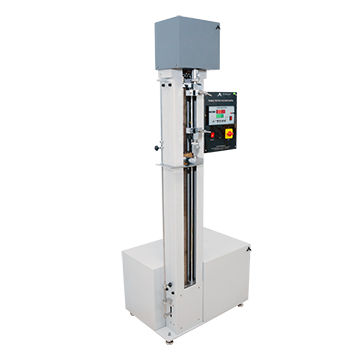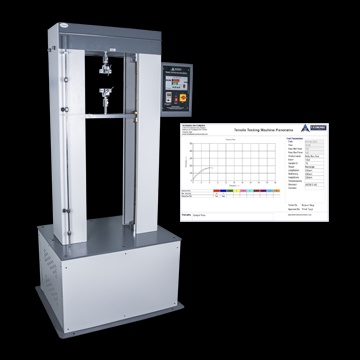Tensile testing machines, also known as pull testers or universal testing machines (UTMs), are electromechanical systems used to evaluate the tensile strength and deformation behavior of a material until it reaches its breaking point. Such a system typically consists of a load cell, crosshead, extensometer, specimen grips, electronics and a drive system.

Tensile tester’s operation is managed by test software that can configure the machine's settings and store parameters according to standards like ASTM and ISO. With this equipment, the force applied to the sample and its elongation is measured throughout the duration of the experiment in order to inform designers on how materials will perform when put into use.
What is a tensile test
Tensile testing is an experiment used to measure a material's response to an applied pulling force. This test will tell us the ultimate tensile strength, maximum elongation, and reduction in area of the material. From these values, other traits are calculated, such as Young’s Modulus (stiffness), Poisson’s Ratio (width-length ratio), Yield Strength (maximum stress before permanent deformation), and strain-hardening characteristics (resistance and hardness increase). Knowing this information allows manufacturers to make decisions when choosing materials that possess the right balance between ductility and strength.
Common Elements Found in a Universal Tensile Testing Machine
A universal tensile testing machine usually consists of load cells, extensometers, specimen grips, a moving crosshead, electronics, a drive system and software.
- Load cells are specifically designed to guarantee high product quality as well as compatibility with all other components.
- Extensometers measure the strain of specimens in accordance with popular standards such as ASTM and ISO.
- Specimen grips enable the mechanical connection between the specimen and the testing machine while transferring the test force to the load cell.
- The moving crosshead directs the speed of the testing process which affects the strain rate of a specimen.
- Electronics supply power to parts that are in motion, like motors and controllers which control their speed and torque.
Automated tensile testing
During automated tensile testing, specimens are removed from a magazine and inserted into the specimen grips of the machine by a robotic testing system. A 2D code reader, cross-section measuring device or, depending on the test, a hardness tester or roughness measuring system can also be connected. The automated tensile testing system also disposes of specimen remains.
Robotic systems offer a range of advantages when conducting tensile tests. Regardless of the size of the test series, from small to large amounts, these systems can help operators reduce routine tasks and improve accuracy and reproducibility of test results. They can also be used 24/7 with no need for operator attendance. By eliminating any subjective influences in the testing process, such as hand temperature or uneven specimen gripping, laboratories are assured a consistent level of precision.
Applications of Tensile Testing Machine
Tensile testing has a multitude of applications. For example, it is used in the creation of plastic packaging, to determine its protective qualities against pulling forces encountered during transit. It is also leveraged in the making of concrete-reinforcing steel bars for meeting quality standards as well as to measure yield strength and other properties. Lastly, rubber compounds for tires are tested thoroughly for their tensile strength and elongation to guarantee safety upon market release.
What to look out for when choosing tensile testing machine
When it comes to selecting a tensile testing machine, there are several key aspects that must be taken into account: quality, reliability of results, cost and application. In addition, flexibility is an integral factor as the machine should have the capability to test a wide range of materials with varying load requirements. It should also be possible to operate it with or without a computer and it should be modular in structure so that fixtures and specimen grips can be adjusted as required. Safety should also be a consideration – from outside safety doors and interlocks to internal software monitoring and user-management capabilities. Furthermore, ease of use is essential. operators must be able to install & set up test configurations quickly & efficiently whilst being able to interpret results easily. And finally, adaptability – the tester must have the ability to conform to updated standards & market changes over time.
Testing software is designed to make the testing process easy for the operator, while providing them with standard-compliant test configurations. It includes a library of over 600 standard test programs, so you can select the appropriate one for your application; saving time and reducing possibility of errors.
Automation is becoming more prevalent in materials testing due to its ability to reduce disruptions that may alter measured values – from simple labs using collaborating robots up to fully automated testing facilities working 24/7.


No comments yet